Running your own business has always meant juggling many different and competing responsibilities on a daily basis. The priorities can range from optimising a website and writing a killer marketing strategy to invoicing clients and ordering stationary. The jobs are varied and never-ending. One of the most difficult and yet also most crucial areas though, is making sure that you get paid by customers and clients. Without this vital cash flow through the business, operations can quickly grind to a halt, and yet as crucial as it is, it’s an area that a lot of entrepreneurs struggle with initially. Often clients don’t mean to be late with a payment, but their own financial processes are not optimised. However, you do always get some customers and clients that try to deliberately delay or avoid payment. You must be able to deal with this if you want to make a success of your company – here’s how to make sure that you get paid:

Make It Easy
It stands to reason that if you want to get paid promptly, you need to make it easy to do. Using well-adopted systems such as PayPal to process customer payments, and invoicing systems like QuickBooks mean there are tools at hand that help people to make a payment to you swiftly and easily – all of which means you are more likely to get paid on time! It’s worthwhile opting for great IT support that enables you to verify customer IDs in real time, issue invoices on the go and otherwise streamlines financial processes – both for you, and for those that you rely upon to get paid.
Create A Strong Contact
It seems simple, but it’s astounding how many small businesses operate without properly written contracts. You may believe that operating on a ‘gentleman’s agreement’ builds goodwill, but you’re only paving the road for disagreements and contentious issues further down the line. It’s good practice to protect both yourself and your clients by making things clear from the start. If you set out your terms of payment, it becomes easier to chase up any violations of this in a timely manner. You’ll need to set out the parameters in a written contract document, specifying exactly what services or goods you’re supplying, your rate and estimated charges, the date of expected completion, what date from that point you expect remittance to be made, and who at your end will be dealing with the financials (either yourself or a named person). You also need to cover off a few unpleasant eventualities, such as what will happen when you don’t get paid, what happens if the project gets cancelled after the agreement, and how you will be compensated for any alterations.
Keep It Sweet
There’s no reason why you can’t use the touchpoint of invoicing to improve relationships. Take the opportunity to include a personalised thank-you note to customers or clients, and give them something – a discount for repeat business, or a small gift can make your business stand out. Even just the basics of adding a line or two thanking the person for their business on the invoice itself can have a big impact. It’s also wise to keep a log of who is paying on time and who isn’t. You then have the opportunity to follow up and get to the bottom of why a consistent late payer is in that situation – and then make the decision as to whether you want to continue to do business with them or withdraw and focus on projects that have more of a chance of getting paid on time.




